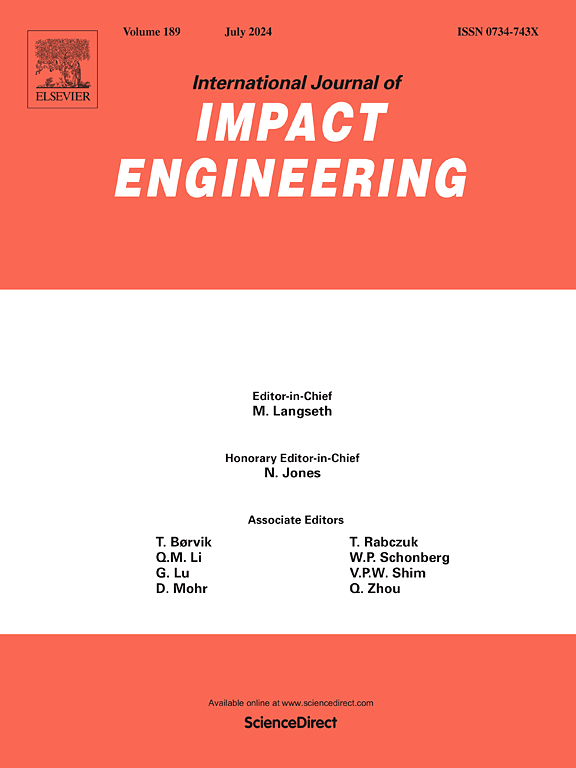基于标度理论的水下爆炸下舰船结构冲击响应相似性研究
IF 5.1
2区 工程技术
Q1 ENGINEERING, MECHANICAL
International Journal of Impact Engineering
Pub Date : 2025-03-24
DOI:10.1016/j.ijimpeng.2025.105333
引用次数: 0
摘要
船体结构对水下爆炸的冲击响应是一个典型的瞬态强非线性过程,其动态响应的特点是分岔和突变,从而导致系统动态行为的不确定性。基于经典相似性理论的传统预测方法很难提供准确的预测。针对水下爆炸模型试验中的相似性变换问题,本文在经典相似性理论的基础上引入了缩放理论。它解释了经典相似性理论中观察到的失真现象,并推导出一个满足缩放理论的模型试验相似性缩放变换方程。本文还深入探讨了该缩放变换方程的应用范围。为了描述模型和原型之间的相似比特征,论文引入了基于分形和自相似原理的重正化群理论,定义了模型试验的大、中、小尺度比。以某舰船的框架和剖面结构为原型,根据本文确定的大、中、小尺度比设计了一系列模型试验。通过同尺度和跨尺度模型试验,充分验证了基于比例理论的船体结构水下爆炸冲击响应相似性比例变换方程的有效性和普适性。研究结果表明,基于重正化群理论定义的大、中、小尺度比可以明确规定模型试验设计中的尺度比范围。与经典相似性理论相比,基于比例理论推导出的船体结构模型试验对水下爆炸冲击响应的相似性比例变换方程,可以有效地应用于同比例和跨比例条件下的原型,突破了模型试验中参数变化范围的限制。本文章由计算机程序翻译,如有差异,请以英文原文为准。
Research on the similarity of ship structure's shock response under underwater explosion based on scaling theory
The impact response of a ship's hull structure to an underwater explosion is a typical transient and strongly nonlinear process, characterized by bifurcations and abrupt changes in its dynamic response, leading to uncertainties in the system's dynamical behavior. Traditional prediction methods based on classical similarity theory struggle to provide accurate forecasts. To address the issue of similarity transformation in underwater explosion model tests, this paper introduces scaling theory on the basis of classical similarity theory. It explains the distortion phenomena observed in classical similarity theory and derives a similarity scaling transformation equation for model tests that satisfies scaling theory. The paper also delves into the scope of application of this scaling transformation equation. To describe the similarity ratio characteristics between models and prototypes, the paper introduces the renormalization group theory based on fractal and self-similarity principles, defining large, medium, and small scale ratios for model tests. Taking the frame and section structures of a certain ship as prototypes, a series of model tests are designed according to the large, medium, and small scale ratios established in this paper. Through same-scale and cross-scale model tests, the effectiveness and universality of the similarity scaling transformation equation for the impact response of a ship's hull structure to underwater explosions, based on scaling theory, are fully verified. The research results indicate that the large, medium, and small scale ratios defined based on the renormalization group theory can clearly specify the range of scale ratios in model test design. Compared to classical similarity theory, the similarity scaling transformation equation for the impact response of a ship's hull structure model test to underwater explosions, derived based on scaling theory, can be effectively applied to prototypes under both same-scale and cross-scale conditions, breaking through the limitations of parameter variation ranges in model tests.
求助全文
通过发布文献求助,成功后即可免费获取论文全文。
去求助
来源期刊

International Journal of Impact Engineering
工程技术-工程:机械
CiteScore
8.70
自引率
13.70%
发文量
241
审稿时长
52 days
期刊介绍:
The International Journal of Impact Engineering, established in 1983 publishes original research findings related to the response of structures, components and materials subjected to impact, blast and high-rate loading. Areas relevant to the journal encompass the following general topics and those associated with them:
-Behaviour and failure of structures and materials under impact and blast loading
-Systems for protection and absorption of impact and blast loading
-Terminal ballistics
-Dynamic behaviour and failure of materials including plasticity and fracture
-Stress waves
-Structural crashworthiness
-High-rate mechanical and forming processes
-Impact, blast and high-rate loading/measurement techniques and their applications
 求助内容:
求助内容: 应助结果提醒方式:
应助结果提醒方式:


